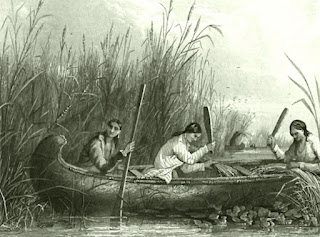A Brief History of Birchbark Canoes in Michigan
I have a hobby that, until now, I've not written about here at POI: I enjoy making miniature birchbark canoes. The designs I use pay tribute the Ojibwa/Ottawa Indians of the Great Lakes Region.
Each hand-crafted model takes about four hours to make using hand-cut, steamed, and sewn materials from Michigan’s Upper Peninsula. As was true of the large canoes that once whispered across Michigan's lakes and streams, each canoe is different in color and detail. For decades, these small models have made unique gifts for Michigan historians, folk-art collectors, and sportsman. (In my case, I wanted one as a souvenir on a camping trip, but couldn’t afford it. So my dad made my first in 1964.)
Each canoe is signed and dated (never know, in 100 years they may be collectible on “Antiques Road Show”😉) Each canoe rests in a small stand made from bits of a deer hide from my father’s 1965 hunt in the U.P..
Watch some of the process on my YouTube channel:
Woodlands Indian tribes in our region were different from those depicted in American “Western” movies in that they relied more on fishing, hunting, and the fur trade with early settlers than did their western counterparts. Because of this interdependence with Michigan’s great outdoors, particularly with rivers and lakes, the Ojibwa/Ottawa tribes became master craftsman of birch, and for centuries birchbark canoes and birchbark teepees lined their villages.
White birchbark is strong and somewhat flexible when fresh. It sheds water and resists rot. It can be harvested from felled trees in lengths 10’ or more. When removed in full thickness it is similar to rawhide or shoe-leather. A model canoe requires only a sheet the size of 8.5x11 notebook paper, but a real canoe began with the "skin" of two large birch trees with seams sealed with pine tar.
Expert craftsmen continue to make full-sized birchbark canoes in the Great Lakes region. The skills and techniques now used actually exceed what was possible for Native Americans in pre-colonial America. An example of such an artisan’s work from beginning to end may be seen at this link.
Miniature birchbark canoes, however, can be made from smaller thinner patches peeled from the outer layers of bark. Removing such samples does no harm to the living tree which routinely “sheds”the outer layers of bark over the course of many years. Birchbark used for miniature canoes can also be harvested from fallen birch trees commonly seen near water sources in Michigan woodlands.
Birchbark is also a source of medicinal oils once used by indigenous tribes and still included in “essential oils” today. The oil in the bark makes it resistant to moisture, insects, and rot. It is interesting to note that the birch wood itself is much more vulnerable to decay. This is why hikers often observe that the bark of a fallen birch retains its shape long after the wood inside has turned to pulp.
My fascination with miniature birchbark canoes began in 1964 at Black Lake State Forest near Cheboyban, Michigan. 'When we got back to the campground we retraced our steps down a path into the woods. The dead porcupine was gone, but sure enough there was a birch log I’d paid no attention to the day before. Using his small hatchet and knife, Dad pulled off two patches of bark about the size of a handkerchief. The bark was still moist and came off with little effort. I later learned that birchbark can also be harvested from living trees without harm—so long as you make only vertical cuts and remove only the “outer bark,” leaving the “inner bark” (called cambium) in tact.
I still have that first birchbark canoe from 1964. You can see it in the video link at the end of paragraph one. To this day, I remember sitting at a picnic table beside our tent with my dad and siblings. . . doing the best we could to make souvenirs with a few crude tools. What we lacked in craftsmanship we made up for in time well spent. That little canoe symbolizes a father spending one of his hard-earned vacation days with his kids in Michigan’s great outdoors, putting natural resources to enduring use, strengthening family bonds, and creating a connection between present and past. It is in that respect, that my first birchbark canoe and all those to follow pay tribute the Ojibwa/Ottawa Indians of the Great Lakes Region.




